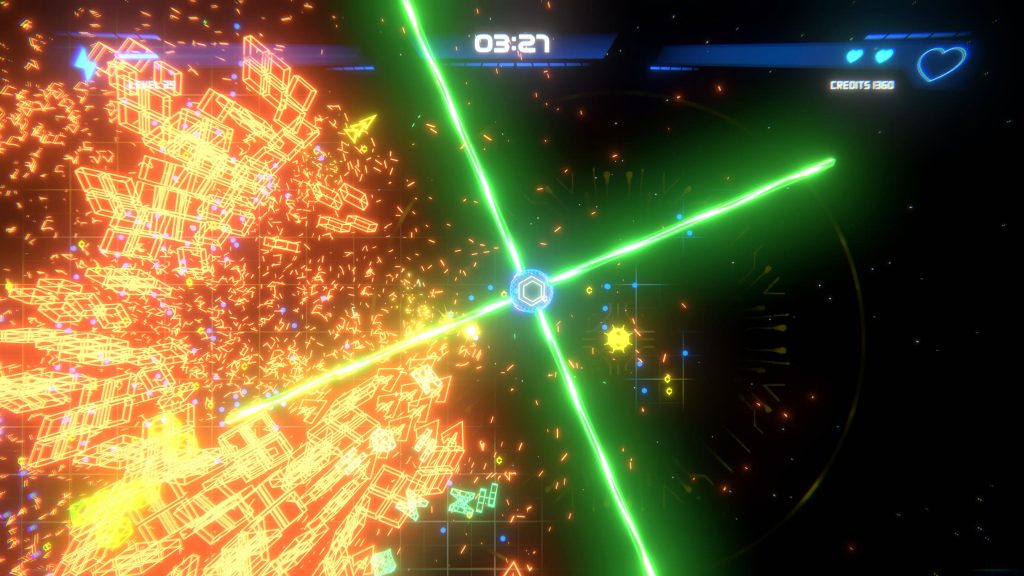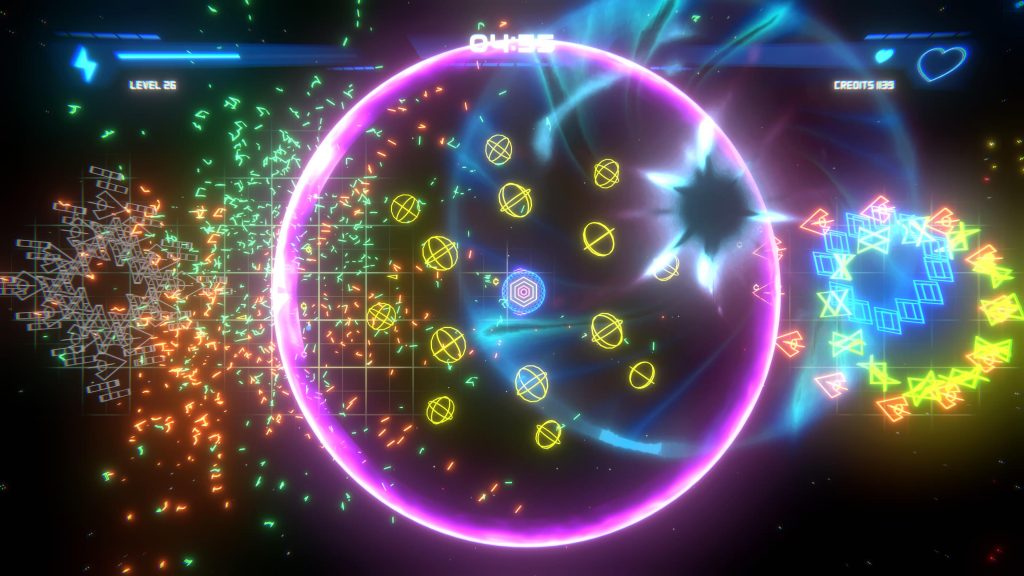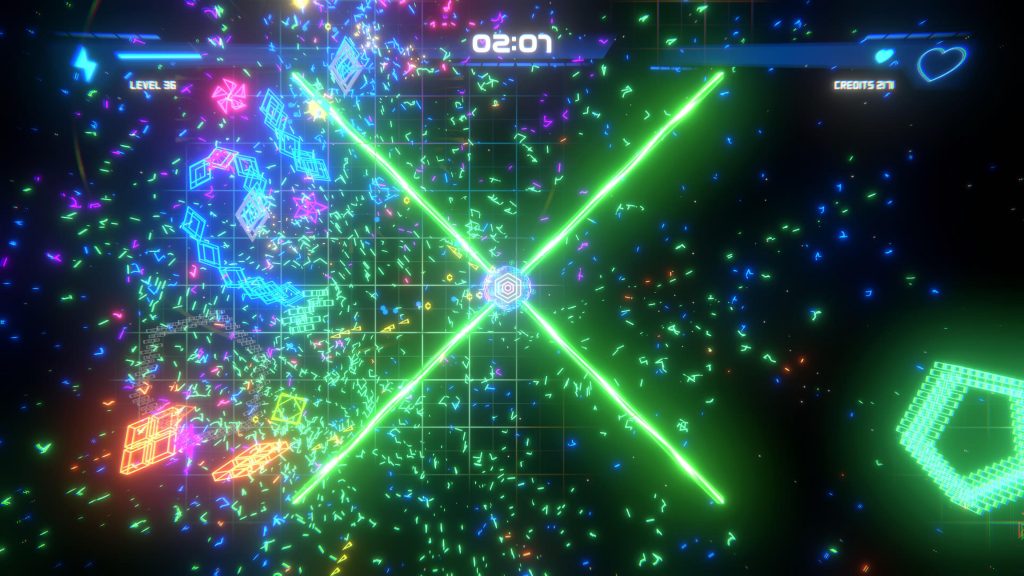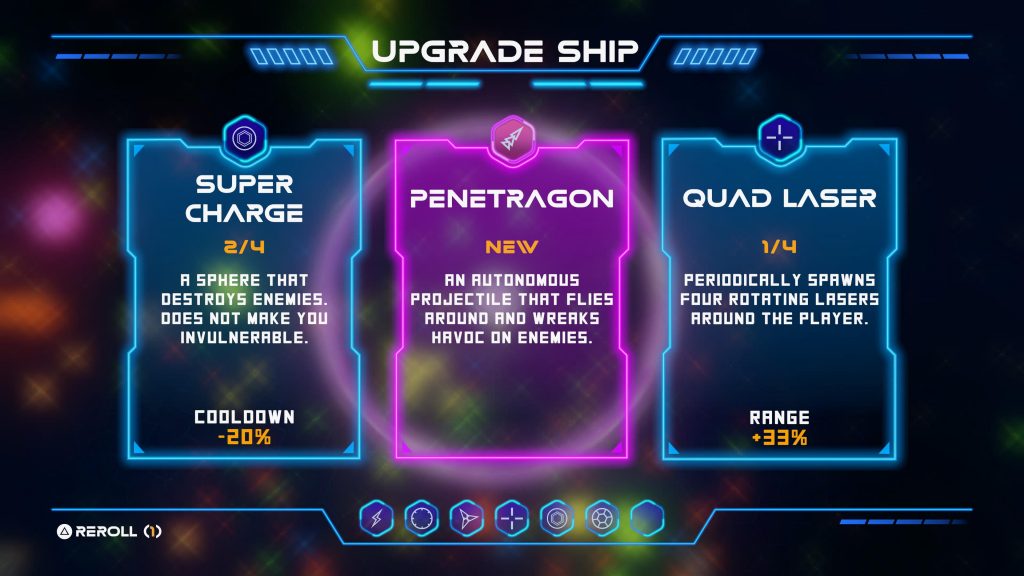Geometry Survivor is an auto-shooter from London-based coders Brain Seal and its name really tells you know what their intentions with this game was. Essentially it’s the latest Vampire Survivors style auto-shooting rogue-lite game to hit PSN and it borrows its aesthetic pretty heavily from Bizarre Creations’ wonderful Geometry Wars series. That is to say that for the twenty minutes that the game challenges you to survive for, you’ll be hunted down by faux-vector graphic monochrome shapes all intent on doing you serious harm.
The game offers one real mode and that’s ‘Survival’ where you’ll start in the middle of an arena where enemies materialise around you and make a beeline right for you. As is common in this genre, your only control is the left-stick. Your ship fires at whichever enemy is nearest and you can’t influence that on most of the weapons you’ll unlock (with a couple of exceptions). You don’t fire all that quickly though and so your dodging skills will be put to the test.
 In true Geometry Wars 2 fashion, some enemies will drop little blobs. Yellow ones give you credits which can be spent in a shop that is only available outside of gameplay but can be used to boost certain aspects of play for you, the green ones help to level you up in gameplay (but that progress is lost when you die or finish the mode). Once you level up you’ll get the option of three randomised weapons/perks. These can speed up your main ‘auto-fire’ weapon, improve movement speed, increase your defences or, most interestingly, add new weapons.
In true Geometry Wars 2 fashion, some enemies will drop little blobs. Yellow ones give you credits which can be spent in a shop that is only available outside of gameplay but can be used to boost certain aspects of play for you, the green ones help to level you up in gameplay (but that progress is lost when you die or finish the mode). Once you level up you’ll get the option of three randomised weapons/perks. These can speed up your main ‘auto-fire’ weapon, improve movement speed, increase your defences or, most interestingly, add new weapons.
It’s all very typical of the genre really. If you’ve played Vampire Survivors or Brotato, you’ll feel right at home here with the basic mechanics of the game. But that’s also where the problems start for the game. Especially as Brotato was the last game I reviewed and it happens to be the best example of the genre, so Geometry Survivor was following true greatness which was always going to be a tough task.
 That’s not to say it’s a bad game. Indeed, far from it, this is one of the better games in the genre, especially of the ones that have made it to PSN. It’s just that the overall meta-structure of the gameplay is slightly off. What we really did like is how we managed to go from absolutely sucking at the game to dominating on it without really unlocking anything. We just got used the mechanics and pace of the game and improved a bit with each attempt. And the further you get into each twenty minute run, the better the game gets. Where the first few minutes are pretty staid and unexciting, the last few are pretty glorious with the screen awash in laser-coloured destruction and madness.
That’s not to say it’s a bad game. Indeed, far from it, this is one of the better games in the genre, especially of the ones that have made it to PSN. It’s just that the overall meta-structure of the gameplay is slightly off. What we really did like is how we managed to go from absolutely sucking at the game to dominating on it without really unlocking anything. We just got used the mechanics and pace of the game and improved a bit with each attempt. And the further you get into each twenty minute run, the better the game gets. Where the first few minutes are pretty staid and unexciting, the last few are pretty glorious with the screen awash in laser-coloured destruction and madness.
But what the game gets wrong is all the stuff that made Brotato and Vampire Survivors so compelling and that’s in the upgrades, both in and out of the game. In the game there aren’t all that many weapons to find and many of them are pretty useless. Some are great such as the sphere of death that allows you to charge into hordes of enemies, the Quad Laser that rotates and sweeps through swathes of nearby dangers or the recharging shield. But there are loads that just felt weak and useless. Also, your main weapon feels like a particularly slow pea-shooter and even when you fully upgrade it, you barely notice it. Indeed, we ended up turning down the music and boosting the sound effects because at first everything was so flat and undynamic.
 Like we said though, when you do fully build up your arsenal and the enemies start to really show up in numbers, the game feels great. It’s just that it could have been even better if those upgrades were better and that goes even more for the shop upgrades. While you’ll get tons of credits if you survive late into the game, early progress is slow and so it’s a shame that in the permanent upgrades you get from the shop are so uninspiring.
Like we said though, when you do fully build up your arsenal and the enemies start to really show up in numbers, the game feels great. It’s just that it could have been even better if those upgrades were better and that goes even more for the shop upgrades. While you’ll get tons of credits if you survive late into the game, early progress is slow and so it’s a shame that in the permanent upgrades you get from the shop are so uninspiring.
You know exactly what you want from a shop like that. More projectiles, more range, more piercing, more spread, more destruction. But instead the list is so uninspiring. The most useful upgrade lets you level up a bit quicker in the game but the rest go from okay (earn more credits, move a bit faster) to literally useless. One of them even makes the game harder. The whole point of a rogue-lite game is that the progression should be rewarding to the point of being addictive but Geometry Survivor doesn’t nail that at all.
 Credits can also be spent on new ships but again this isn’t very well implemented as we didn’t like the look of any of them, especially given how many credits it takes to unlock them. And while many players won’t care about trophies, the list here really doesn’t inspire further play as there are just twenty and each one is for surviving each minute of the game. That’s right. You complete one run of Survival and you’ll have the Platinum. Even though you could have had trophies for beating games with the various ships. And with no leaderboard or anything else to encourage further play, once you’ve beaten the game you’ve not really got much of an incentive to keep going. Now, given that I spent 230 hours beating every character on Brotato on the Switch (for no trophies/achievements), it’s a shame that Geometry Survivor didn’t try to offer any real reasons to spend a lot of time playing here.
Credits can also be spent on new ships but again this isn’t very well implemented as we didn’t like the look of any of them, especially given how many credits it takes to unlock them. And while many players won’t care about trophies, the list here really doesn’t inspire further play as there are just twenty and each one is for surviving each minute of the game. That’s right. You complete one run of Survival and you’ll have the Platinum. Even though you could have had trophies for beating games with the various ships. And with no leaderboard or anything else to encourage further play, once you’ve beaten the game you’ve not really got much of an incentive to keep going. Now, given that I spent 230 hours beating every character on Brotato on the Switch (for no trophies/achievements), it’s a shame that Geometry Survivor didn’t try to offer any real reasons to spend a lot of time playing here.
So that’s the story of the game. Initially a little underwhelming, then kind of brilliant and, finally, over just as things were going so well. The core mechanics are good, the presentation is on-point but the overall structure needs a lot of work. So while Geometry Survivor might not keep you interested for too long, we’d be all over a sequel in a heartbeat. There’s a ton of unrealised potential here.
+ Good core auto-shooting mechanics
+ The Geometry Wars aesthetic is used to good effect
+ Difficulty curve was good
- Not many reasons to come back to it once beaten

